Investigation of optimum discharge characteristics and chemical activity of AC driven air plasma jet and its anticancer effect
2022-01-10SansanPENG彭三三DehuiXU许德晖MiaoQI祁苗RongLIU刘蓉XinyingZHANG张新颖HuaiyanZHANG张怀延BolunPANG庞波伦JinZHANG章金HaoZHANG张浩ZhijieLIU刘志杰andDingxinLIU刘定新
Sansan PENG (彭三三), Dehui XU (许德晖), Miao QI (祁苗),Rong LIU (刘蓉), Xinying ZHANG (张新颖), Huaiyan ZHANG (张怀延),Bolun PANG (庞波伦), Jin ZHANG (章金), Hao ZHANG (张浩),Zhijie LIU (刘志杰),∗and Dingxin LIU (刘定新),∗
1State Key Laboratory of Electrical Insulation and Power Equipment, Centre for Plasma Biomedicine,Xi’an Jiaotong University, Xi’an 710049, People’s Republic of China
2 The School of Life Science and Technology,Xi’an Jiaotong University,Xi’an 710049,People’s Republic of China
Abstract In this study,we investigated the effects of the quartz tube diameter,air flow rate,and applied voltage on the characteristics of an air plasma jet to obtain the optimized discharge characteristics.The physicochemical properties and concentration of reactive oxygen and nitrogen species (RONS) in plasma-activated medium(PAM)were characterized to explore their chemical activity.Furthermore,we investigated the inactivation effect of air plasma jet on tumour cells and their corresponding inactivation mechanism.The results show that the tube diameter plays an important role in sustaining the voltage of the air plasma jet,and the gas flow rate affects the jet length and discharge intensity.Additionally, the air plasma jet discharge displays two modes, namely, ozone and nitrogen oxide modes at high and low gas flow rates,respectively.Increasing the voltage increases the concentration of reactive species and the length of discharge.By evaluating the viability of A549 cells under different parameters,the optimal treatment conditions were determined to be a quartz tube diameter of 4 mm,gas flow rate of 0.5 SLM,and voltage of 18 kV.Furthermore,an air plasma jet under the optimized conditions effectively enhanced the chemical activity in PAM and produced more aqueous RONS.The air plasma jet induced significant cytotoxicity in A549 cancer cells after plasma treatment.H2O2 and −NO2 are regarded as key factors in promoting cell inactivation.The present study demonstrates the potential use of tumour cell therapy by atmospheric air PAM, which aids a better understanding of plasma liquid chemistry.
Keywords:cold atmospheric plasma,discharge characteristics,reactive species,plasma-activated medium, anticancer effect
1.Introduction
Cold atmospheric plasmas (CAPs) have attracted increasing attention in biomedical applications for the past few years[1–3].As a cancer treatment strategy, CAPs offer the possibility of achieving membrane permeability [4–6] and selectively targeting cancer cells without affecting normal cells[7–9].Currently, CAPs are not only widely used in the preclinical development of anti-cancer therapies, including ovarian, malignant melanoma, lung, liver, and breast cancer[10–13],but also used in clinical studies[14].Among various CAP sources, atmospheric pressure plasma jets (APPJs) are generated in an open space between the electrodes rather than in a narrow gap.This allows for the processing of samples with complex 3D structures such as skin[15],teeth[16],and tubes [17], and even allows for the direct delivery of plasma onto treated tissues and cells.Depending on the electrode structure, APPJs can be classified into two types.One is marked by a plasma (the active region) produced directly between the bare metal electrodes, which leads to a spark or glow discharge observed in the electrode gap [12–17].The other is to separate the high-voltage (HV) electrode from the ground electrode using a dielectric tube, which generates discharge to produce plasma.
In general, APPJs using inert gases (such as Ar and He)have been widely studied because of their advantages such as high stability and rich reactive species(such as OH,NO,and O3)[18–20].In addition,several different existing APPJs rel y on external power supply and supply gas (e.g.cylinders,valves, flow controllers) [21, 22], which limits their use in emergency situations such as emergency ambulance calls,natural disaster relief, and medical treatment in remote areas[18–20].Furthermore,in view of the economic cost,air is less expensive than noble gases.However, it is difficult to maintain a non-equilibrium air plasma jet at atmospheric pressure because of the presence of electronegative oxygen(O2)in the air [23].To date, several air APPJs have been reported[23–28].Luet aldeveloped an appropriate device for localized plasma treatments whose plumes are typically very small [23].The plasma jet arrays were reported by Wuet al[28], which might be a promising approach to solve the increasing treatment area.However, it is difficult to obtain uniform plasmas because individual plasma plumes are independent of each other in most cases.To solve this problem, it is critical to control the discharge parameters of air APPJ to realize the optimized characteristics.
In this study, a plasma jet device with the use of air as a feedstock gas was applied to study the discharge characteristics of the plasma jet and understand the role of flow,applied voltage,and quartz tube diameter in an air plasma jet under a high alternating voltage (AC) voltage.The physicochemical properties (oxido reduction potential (ORP) and pH value) and concentration of reactive oxygen and nitrogen species (RONS: ROS and RNS) in plasma-activated medium(PAM)were characterized to explore the chemical activity of the liquid phase, and Fourier transform infrared spectrometer(FTIR)absorption and emission spectra were used to explore the characteristics of the gaseous phase.Furthermore,with the optimized discharge characteristics and chemical activity, the inactivation effect of tumour cells induced by air plasma jet and the corresponding inactivation mechanism was investigated.
2.Experimental setup and methods
2.1.Air plasma jet device
A schematic of the plasma jet used in this study is shown in figure 1(a).The plasma jet source uses a needle-to-ring electrode structure,and the HV electrode is a hollow stainless steel dispensing needle with an inner diameter of 1.55 mm and an outside diameter of 1.83 mm.It is 0.5 inch long and allows working gas to pass through it.The outer layer of the device is a quartz tube with a length of 5 cm,and quartz tubes with outer diameters of 3, 4, 5, and 6 mm and a thickness of 1 mm were used.The ground electrode, a copper ring with a width of 0.5 cm, is 4 mm from the tube end.The downward direction of the ground electrode to the quartz tube orifice is considered as the downstream direction, while the upward direction of the ground electrode is considered as the upstream direction (see figure 1).The power supply is a sinusoidal AC with a frequency of 20 kHz.As shown in figure 1(b),the waveform voltage and current were measured using an oscilloscope (Tektronix, Mixed Domain Oscilloscope 3000, Xi’an, China) with a HV probe (Tektronix,P6015A) and a current probe (Person 6021).The APPJ discharge image was captured using a digital camera (Nikon D7200) with an exposure time of 0.5 s.
2.2.Measurements for gaseous and aqueous RONS and physicochemical properties
To investigate the gas phase composition and explore the influence of gas flow rate and voltage amplitude on its composition and content, the generated plasma exhaust gas was directly sent to a FTIR (Bruker, Tensorii) to detect the gaseous RONS with wave numbers ranging from 500 to 2500 cm−1[29,30].An Endor SR-750i was used to detect the optical emission spectrum (OES) of the rich reactive substances in the plasma grating monochromator (grating grooving 1200 lines mm−1).The light of the plasma was collected by an optical fibre perpendicular to the centre of the quartz tube, which was focused on the jet plume, and the spectrum was measured by moving the focus position by adjusting the height in the vertical direction.In the experiment, a 48-well plate containing 400 μl Roswell Park Memorial Institute (RPMI) 1640 medium was placed downstream of the plasma with applied voltage of 18 kV and the gas flow rate of 0.5 SLM(referred to asV=18 kV andF=0.5 SLM;abbreviated similarly hereinafter).The samples were treated with a pipe outer diameter of 4 mm for 0.5,1,2,3,and 4 min with a distance between the ground electrode and the liquid level kept constant at 15 mm.The outer diameter of the quartz tube is set asD(referred to asD=4 mm; abbreviated similarly hereinafter).After treatment with PAM, the physicochemical properties of the PAM, such as pH and ORP,were measured using a pH meter(Mettler-Toledo,FE20)and an ORP meter (Mettler-Toledo, S210-K) [31].The aqueous long-lived RONS induced by air plasma in the activated medium were measured using different chemical probes.H2O2was detected using a hydrogen peroxide assay kit(Beyotime, S0038), and−NO2was measured using a nitric oxide assay kit (Beyotime, S0024) and a microplate reader(Thermo Scientific, Waltham, MA, USA) was used to detect absorbance at 560 nm(H2O2)and 540 nm wavelength().
2.3.Cell culture and measurement
In order to investigate the effect of air plasma jet on the inactivation of cancer cells, we selected A549 lung cancer cells (ATCC) as the therapeutic target.Non-small A549 lung cancer cells (ATCC) were cultured for 24 h in RPMI 1640 medium containing 10% foetal calf serum, 50 μg ml−1streptomycin (Corning, Ithaca, NY, USA), and 100 U ml−1penicillin in an incubator (Thermo Scientific) at 37 °C in a humidified atmosphere of 5% CO2/95% air.Cells were seeded in 96-well plates(100 μl medium)at a density of 5×103cells/well and at a density of 3×105cells/dish in 35 mm diameter dishes (1 ml medium)for 1 d.Then,the cell culture medium was replaced with 100 μl and 1 ml of PAM in the 96-well plate and 35 mm diameter dishes, respectively, and incubated for 1 d.The PAM was treated at different times(0.5, 1, 2, 3, and 4 min) with a distance between the ground electrode and the liquid level kept constant at 15 mm under different experimental conditions(various voltages,gas flows,and quartz pipe diameters) to investigate the effect of air plasma jet on the inactivation of cancer cells.The approach to treat cancer cells is indirect with CAP sources, where the plasma source is used to treat a liquid, such as water, cell culture medium, or physiological solution, and then the biological target is exposed to the plasma-treated liquid[32,33].This makes indirect treatment an advantage since plasma devices can be kept at a considerable distance from the surface [34].In this experiment, we used Trypan Blue staining reagent (Sigma-Aldrich, Shanghai, China) and 7 Sea-Cell Counting Kit (7 Sea biotech, Shanghai, China) to investigate the anticancer effect.The principle of Trypan Blue staining is that normal living cells have a complete membrane structure preventing Trypan Blue from entering cells, and cells with incomplete membranes are stained blue due to increased membrane permeability.Trypan blue staining reagent can be used to visually distinguish living cells from dead cells very easily and quickly.After staining the cells with Trypan Blue staining reagent, the cells were washed once with PBS, and then observed under an inverted microscope(Olympus,IX51)with the inactivated cells being stained blue.The 7 Sea-Cell Counting Kit (7 Sea biotech, Shanghai, China) was used to detect cell viability after 24 h of PAM treatment, and the luminescence was measured using a microplate reader.The apoptosis of A549 cells treated with PAM for 24 h was detected using the Annexin V/PI Apoptosis Kit, and the apoptosis of A549 cells was detected using flow cytometry(Accuri C6, BD Biosciences).The t-test was used to analyze the experimental data of cell viability withp<0.05 considered statistically significant (*p<0.05,**p<0.01, and***p<0.001) and expressed as mean±standard deviation.
3.Results and discussion
3.1.Influence of diameter of quartz tube on air plasma jet
The diameter of the quartz tube is a vital factor in the air plasma discharge.To explore the influence of the pipe diameter on the air plasma jet, the outer diameter of the quartz tube was maintained from 3 to 6 mm.Figure 2 shows the plasma jet charge image obtained using a digital camera with an exposure time of 0.5 s.It can be seen in figure 2 that whenF=6 SLM andD=6 mm, the discharge initially only occurs in the upstream region.When the pipe diameter is reduced to a certain value, both downstream and upstream regions begin to discharge.WhenF=4 SLM andD=6 mm, discharge occurs only in the upstream region.When the pipe diameter is reduced to a certain value, the discharge length in the upstream region increases.Both upstream and downstream discharges occur at a gas flow rate of 1 SLM, and the discharge intensity in the upstream region increased with the decrease in pipe diameter.Therefore,it can be concluded that the discharge intensity increases as pipe diameter decreases.
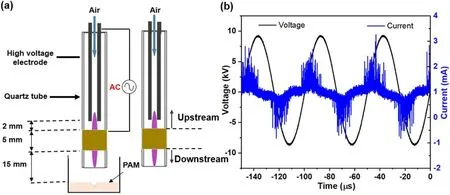
Figure 1.(a) Schematic of the plasma jet device.(b) The waveforms of voltage and current.(D=4 mm, V=18 kV, and F=3 SLM).

Figure 2.The discharge photographs of the air plasma jet as afunction of the diameter of quartz tube with an exposure time of 0.5 s(V=18 kV).
The sustaining voltage is defined as the minimum discharge voltage required to sustain the discharge of air plasma jet.Figure 3 shows the sustaining voltage of the air plasma jet as a function of the gas flow rate and diameter of the quartz tube.It is evident that the sustaining voltage is higher at a gas flow rate of 0.5 SLM and slightly lower at a gas flow rate of 6 SLM, which may because the discharge is unstable at a gas flow rate of 0.5 SLM and the rapid flow of the gas with a gas flow rate of 6 SLM,the particles were blown away, resulting in insufficient discharge.When the gas flow rates were 1, 2,and 4 SLM, the sustaining voltage changed only slightly.As seen in figure 3, the sustaining voltage is the maximum with the different gas flows when the pipe diameter is 4 mm.The decrease in sustaining voltage when the diameter of the quartz tube increased from 4 to 6 mm could be explained by the decreased gas flux per unit cross section.Also,the content of ambient air molecules in the tube is increased at a high gas flux per unit cross section caused by the transition to turbulent mode.The sustaining voltage decreased from 9.2 to 6.1 kV withF=2 SLM when the diameter of quartz tube was increased from 3 to 4 mm.This decrease may be related to the increased purity of the gas.Therefore,it is concluded that the sustaining voltage of the air plasma jet is not related to the gas flow rate but is affected by the diameter of the quartz tube and does not have a linear relationship.

Figure 3.The sustaining voltage of air plasma jet as a function of diameter of quartz tube and gas flow rate.
Figure 4 shows the current waveforms of the air plasma jet obtained atD=3,4,5,and 6 mm,and at an air flow rate of 3 SLM, an applied voltage of 16 kV (F=3 SLM andV=16 kV).It can be seen that the atmospheric air plasma is composed of pulsed current,and the pulsed current generated atD=4 mm is as high as 90 mA, which corresponds to the maximum ignition voltage shown in figure 3.The pulsed current generated atD=6 mm (20 mA) andD=3 mm(50 mA) is less than that generated atD=4 mm (90 mA),which proves that there is no linear relationship between the diameter of the quartz tube and the current.It is worth noting that the current direction(positive or negative)and amplitude are different in the boost and buck half-cycles.This difference may be caused by the difference in electron and ion mobility on the outer surface of the quartz tube with inner diameter.This indicates the formation of a pulsed streamer discharge with a polar effect [32, 35, 36].
3.2.Influence of gas flow rate on the plasma jet
The influence of the gas flow rate on the characteristics of the plasma jet is shown in figure 5.The length of the plasma jet decreased with an increase in the gas air flow when the diameter was kept constant.In contrast,the length of the plasma jet decreased as the diameter of the quartz tube increased from 3 to 6 mm.
Figure 6 shows the length of discharge on the air plasma jet as a function of the air flow rate (D=4 mm andV=21 kV).The length of the plasma jet includes the discharge lengths of the downstream and upstream areas.When the air flow rate was 0.5 SLM, the length of discharge was 5.4 cm.When the air flow rate was 6 SLM, the length of the plasma jet was 1.8 cm.It can be concluded that the air flow rate is one of the factors affecting the air plasma jet discharge,and the discharge intensity is negatively correlated with the gas flow rate.This may be caused by the turbulent mode effect, which results from different drifting velocities of the charged species driven away from the electrode under different gas flow rates.

Figure 4.The current waveforms of air plasma jet obtained at(a)D=3 mm,(b)D=4 mm,(c)D=5 mm,and(d)D=6 mm(F=3 SLM and V=16 kV).
Figure 7 shows the discharge power as a function of the gas flow rate and applied voltage.It can be seen in figure 7 that the discharge power increases with the increase in voltage and increases with decreasing gas flow.This may because the higher the energy obtained with the increase in voltage,more plasma particles are generated.The higher the gas flow, the lower the discharge intensity and the fewer plasma particles produced.
To determine the composition of the main products produced by the air plasma,the products were analyzed using OES.Figure 8 shows the emission spectrum from 200 to 800 nm.The spectrum is mainly composed of the first negative bands of N2+(B2Σ+u→X2Σ+g), the second positive bands of N2(C3Πu→B3Πg), and secondary diffraction of N2(C3Πu→B3Πg).The generation of N2(C3Πu→B3Πg) occurs through the electron impact excitation from the ground state N2(X2Σ+g).The first metastable state N2(A2Σ+u)and N2+(B2Σ+u)states are produced via direct electron collisions with highenergy electrons [36].As can be seen in figure 8, with the increase in gas flow rate, the profile of the emission spectrum remains similar,and the intensity changes slightly.This may be because the accuracy of the detection device was insufficient.Baeket alreported that the gas flow rate is an important factor that affects the plasma discharge [37].Figure 9 shows the absorption spectrum detected by FTIR from 500 and 2500 cm−1on an air plasma jet (F=3 SLM andV=18 kV).As shown in figure 9(a),the main products of the air plasma jet are O3, NO2, and a small amount of N2O, HNO3, and N2O5.Figure 9(b) shows the significant difference between the products of the air plasma jet at low and high gas flow rates.It is worth noting that the concentration of NOxincreases with a decrease in the concentration of O3.At a high gas flow rate, the main products are O3and N2O.Small amounts of N2O5, NO, and NO2were almost undetectable.At a low gas flow rate, the main products are NO2,HNO3,N2O,and N2O5;almost no O3was detected.It can be concluded that the discharge mode displays ozone and nitrogen oxide modes at high gas flow rates and low gas flow rates, respectively.The reaction relationship among O3, NO, and NO2can be obtained from results of previous studies [38–43].The reactions of O3, NO, and NO2in the exhaust gas are as follows:
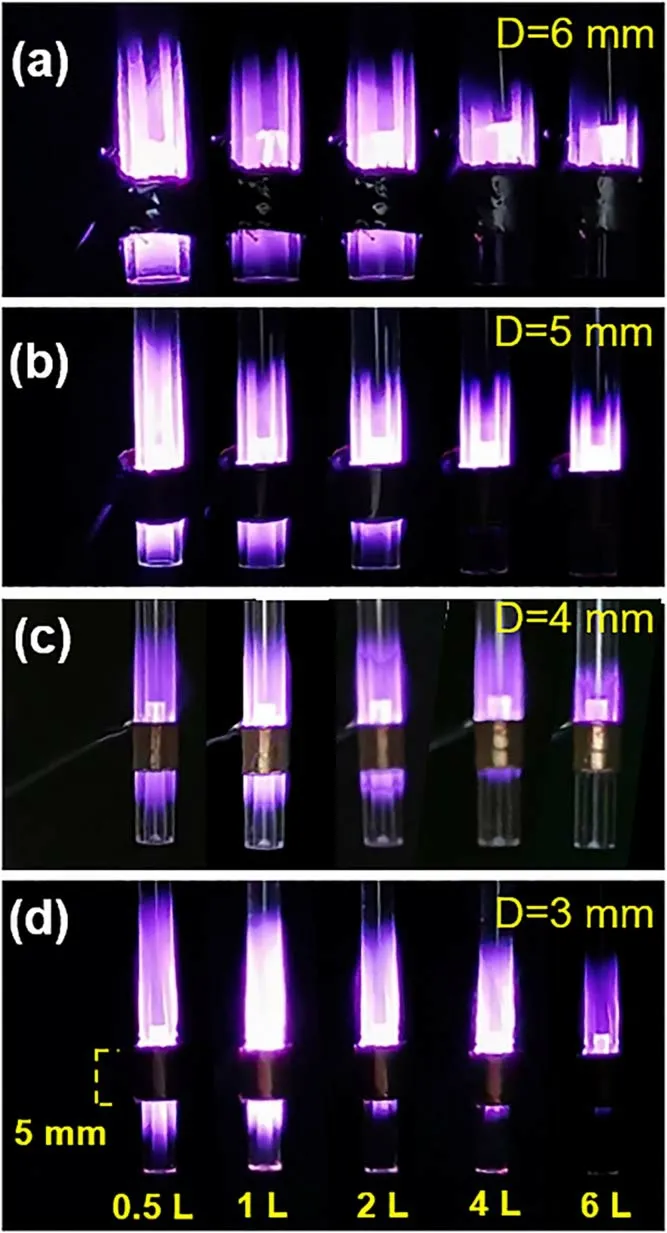
Figure 5.The discharge photographs of the air plasma jet taken by a digital camera(Nikon D7200)with an exposure time of 0.5 s for(a)D=6 mm, (b) D=5 mm, (c) D=4 mm and (d) D=3 mm as a function of the air flow rate (V=18 kV).

Figure 6.The length of discharge on air plasma jet as function of the air flow rate (D=4 mm and V=21 kV).

Figure 7.The discharge power on air plasma jet as function of the air flow rate and applied voltage (D=4 mm).

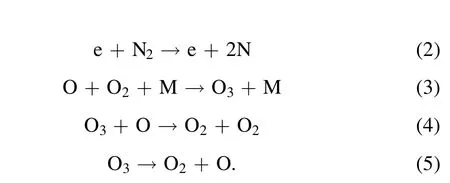
The third colliding molecule is defined as M in reactions(3)and (8), such as O2, O3or N2.The main generation path of O3in air discharge plasma is primarily reaction(1),in which electron collisions cause the dissociation of oxygen molecules and generate free oxygen atoms.The oxygen atoms rapidly react with another molecule of oxygen to form O3through reaction (3).Temperature has a great influence on reactions (4) and (5) and is directly proportional to the reaction rate, which is an important process of mode transition [40].At a high gas flow rate, the flow of gas removes the heat generated by the reactions and the temperature tends to fall, which leads to an increase in ozone density by blocking reactions (4) and (5).
3.3.Influence of applied voltage on the plasma jet
Figure 10 shows the discharge image as the applied voltage is changed.As observed in the figure, no discharge occurs at a voltage of 10 kV, and the length of the plasma jet increases with an increase in the voltage.When the voltage increased to 21 kV, a 1.5 cm jet plume appeared, the voltage increased to 22 kV, and the jet plume reached 2 cm.It can be concluded that the amplitude of the discharge voltage is one of the factors affecting discharge; the higher the voltage, the stronger the discharge.

Figure 8.The emission spectrum of the air plasma jet as a function of gas flow rate(V=18 kV and D=4 mm).(a)1 l,(b)2 l,(c)4 l,and(d) 6 l.
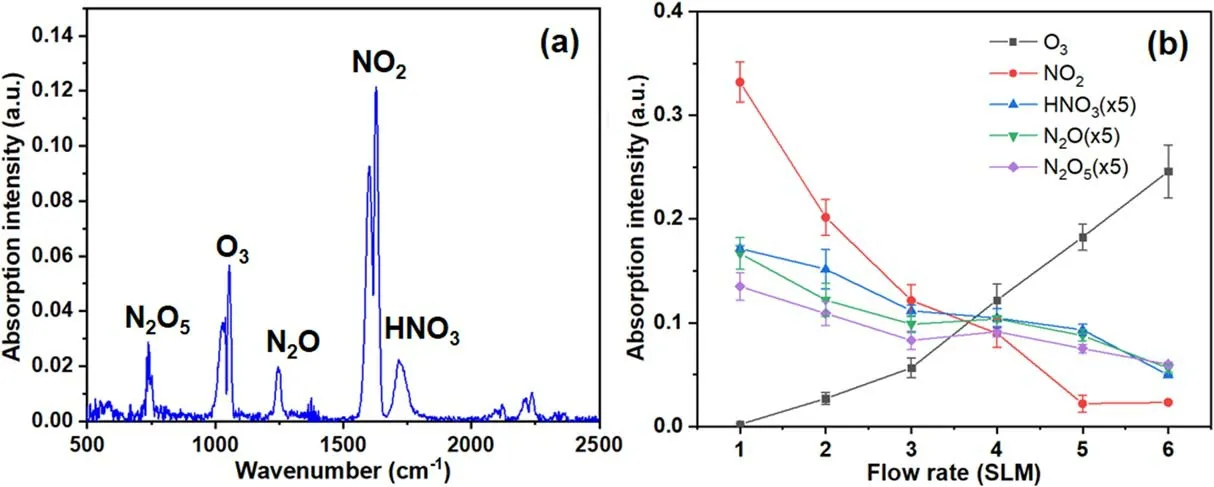
Figure 9.(a)Gas-phase FTIR absorption spectrum of the plasma jet and(b)concentrations of O3,NO2,HNO3,N2O,and N2O5 as a function of gas flow rate.The concentrations of HNO3, N2O, N2O5 are multiplied by 5 for comparison (V=18 kV).

Figure 10.The discharge photographs of air plasma jet as a function of voltage (D=4 mm and F=3 SLM).
As shown in figure 11, with the increase in voltage, the peak value of the emission spectrum is higher, but the basic profile of the emission spectrum remains similar.In other words, the types of gas-phase active particles are basically unchanged during discharge, but the concentration increases with the increase in voltage.This indicates that the air plasma jet can produce a large number of RONS during discharge,and the effect of voltage on discharge is further verified,which may be related to more intense ionization waves penetrating further into the plume and creating more reactive species with higher discharge voltage.To further analyze the influence of the applied voltage on the plasma jet, the emission spectra of the jet and its exhaust gas were analyzed using FTIR spectroscopy.The FTIR absorption spectra under three experimental conditions of 14, 16, and 18 kV were detected,as shown in figure 12.It can be seen in figure 12 that with an increase in voltage,the basic profile of the emission spectrum remains similar.In other words,the types of gas-phase active particles are basically unchanged during discharge, but the concentration changes with the increase in voltage.The spectra showed opposite effects for the concentrations of O3and NO2.The concentration of O3decreases and the concentration of NO2increases when higher voltages are applied.There are two possible reasons for this phenomenon.One is potentially that, as the voltage increases, so does the power(see figure 11).Pavlovichet alreported that under different power density conditions, air discharge would appear as a product pattern dominated by ozone or nitrogen oxides [44].The other reason is temperature.As the voltage increases, so does the temperature.Reactions (4) and (5) are the removal reactions of O3, which are proportional to temperature, and the effect of temperature on reaction (5) is particularly significant [40].Therefore, at low temperatures, the yield of O3is high because of the slow decomposition rate.Reaction (2)involves the dissociation of N2into N (nitrogen atoms).At high temperatures, the formation of O3is inhibited, and the formation of N and N2(A)is promoted.More NO is produced via reactions (6), (7), and (10).Furthermore, reactions (8),(10), and (3) have a competitive relationship in which all the reactants are oxygen and more NO consumes more oxygen and O3to form NO2at high temperatures, which further inhibits the generation of O3.This indicates the effect of voltage on the discharge mode
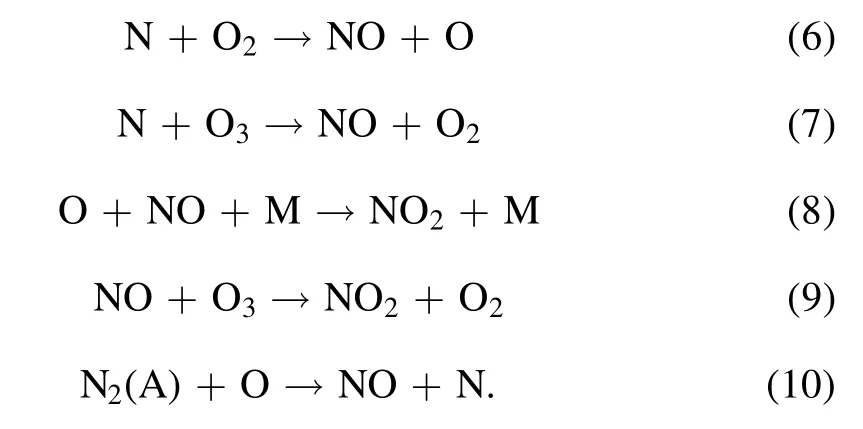
3.4.Inactivation of A549 cell induced by air plasma jet
To study the inactivation effect of cancer cells under the optimal experimental conditions of air discharge and its corresponding mechanism, the viability of A549 cells after plasma treatment under different experimental conditions was quantitatively tested as a function of exposure time.Figure 13 shows the air plasma jet induced cytotoxicity in A549 cells after plasma treatment under different experimental conditions for different times.As shown in figure 13(a), the activation medium treatment atV=18 kV for 1 min can significantly kill cells and maintain a cell survival rate of 42%.After the activation time was increased to 3 min,the cell survival rate dropped to 10%.The activation medium treatment atV=14 or 16 kV for 1 min resulted in a cell survival rate of approximately 90%.Figure 13(b) shows the timedependent cell viability of A549 cells treated with PAM at a constant voltage(V=18 kV)and pipe diameter(D=4 mm)as functions of the gas flow.The activation medium treatment atF=0.5 SLM for 1 min maintained a cell survival rate of 42%, while cell activity was still greater than 80% at 1 SLM and 2 SLM.Figure 13(c) shows the time-dependent cell viability of A549 cells treated with PAM at a constant voltage(V=18 kV)and gas flow(F=0.5 SLM)as functions of the pipe diameter.As can be seen from the figure,the cell activity was the lowest atD=4 mm.The activation medium treatment atD=4 mm for 2 min can significantly kill cells and maintain a cell survival rate of 25%, while the cell survival rate atD=3 or 5 mm is approximately 90%.These results suggest that the optimal treatment condition is a quartz tube diameter of 4 mm,gas flow rate of 0.5,and voltage of 18 kV.
Many studies have shown that RONS play a key role in the inactivation of cancer cells [45, 46].To study the inactivation effect of cancer cells under the optimal experimental conditions of air discharge and its corresponding mechanism,the viability of A549 cells after plasma treatment and the corresponding RONS concentration were quantitatively tested.Figure 14 shows the concentration of long-lived reactive species and the physicochemical properties of PAM induced by the air plasma jet.In figure 14(a), the concentrations of H2O2and−NO2increase steadily with the treatment time,and after 2 min of jet treatment,the concentration of H2O2reached 165 μM and the concentration ofwas 652 μM.

Figure 11.The emission spectrum as a function of applied voltage (D=4 mm and F=3 SLM).
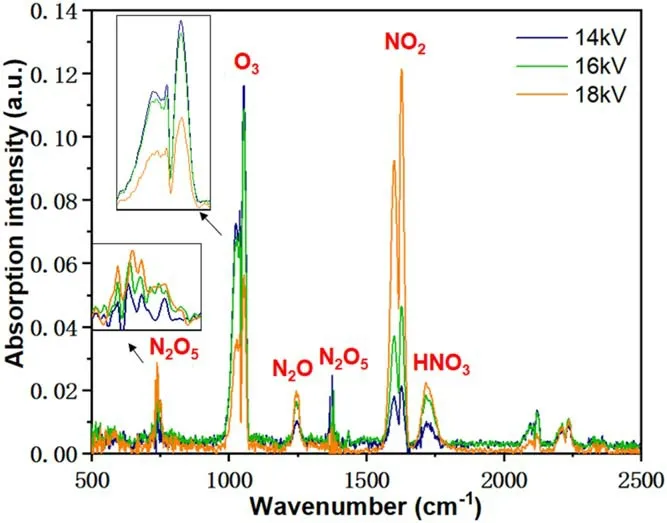
Figure 12.The FTIR spectrum as a function of applied voltage(D=4 mm and F=3 SLM).
The generation pathway is important for analyzing the liquid-phase reactive species.For H2O2, the pathway is mainly the dissolution of the gas-phase H2O2, which is formed by the dissociation of water molecules in the focal plasma region [47].Second, energetic particles impact the ionization of water vapor or H2O molecules in the gas–liquid interface by the collision of high-energy particles through reaction(11).Finally,dissolved oxygen adsorbs low electrons to form O2−through reaction (12), which is regarded as the conjugate base of H2O2.It can produce H2O2in acidic liquid via chemical pathways (14).For NO−2and NO−3,the crucial pathways are reactions (15) and (16) [43, 48].With an activation time between 0.5 and 4 min,the concentration of H2O2increased from 70 to 650 μM, the concentration ofincreased from 155 to 1857 μM, and cell viability dropped from 80%to 13%.Thus,the trend of A549 cell viability was opposite to that of RONS in the activated medium.As shown in figure 13(a), after 1 min of treatment, the concentration of H2O2in PAM was 90 μM, and the cell viability began to decrease significantly.This phenomenon is consistent with that observed in a previous study [46].Xuet alreported that approximately 100 μM H2O2concentration caused morphological changes after 24 h.Hence,cell toxicity may be related to H2O2,,and their synergistic effects in acidic environments related to the PAM mechanism of inducing tumour cell apoptosis
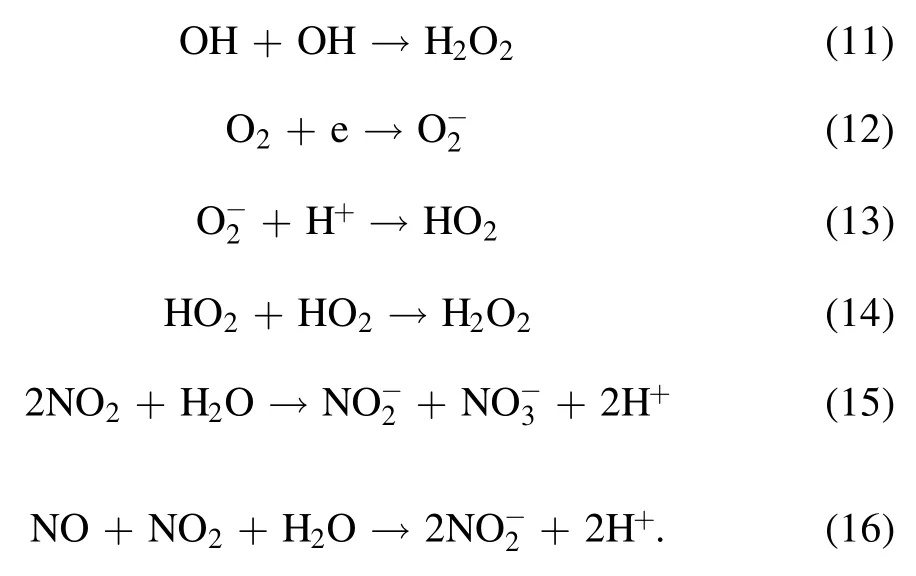
The plasma activation solution can not only produce a large amount of RONS, but also greatly change the physical and chemical properties of the liquid, such as the ORP and pH value.Therefore, it is necessary to explore the changing trend of the physical and chemical properties of PAM with different treatment times to better understand the chemical properties of PAM.Figure 14(b) shows the ORP and pH values of PAM as a function of the treatment time.ORP is an indicator of the oxidizing capacity of a solution relative to the concentration of an oxidizer and is commonly used to evaluate the global level of RONS in PAM.As shown in figure 14(b), when the treatment time increased from 0 to 4 min, the redox potential of PAM decreased from 250 to 207 mV, showing a nonlinear relationship.It can be concluded that with an increase in treatment time, the oxidation process of PAM gradually decreases in a nonlinear fashion.In contrast, with the increase in treatment time, the pH value of PAM showed an upward trend from 7.7 to 8.3.Previous studies have confirmed that the change in the pH values of the activation solution is not a simple process.The generation of HNO2and HNO3in PAM is caused by the reaction of gaseous NOxspecies with H2O molecules, which can produce many H+ions,leading to a rapid drop in the pH values of the treated solution [29, 49].An interesting phenomenon to note is that ORP and pH display opposite trends with treatment time, which may be because PAM is more oxidizable at a lower pH value.Zhouet alreported that the combined action of high ORP and low pH values of PAM is more conducive to cell inactivation [30].
To gain a more intuitive understanding of the situation of cell apoptosis,images of dead cells stained with Trypan Blue staining reagent were obtained.Figure 15(a) shows the coloured images of the plasma jet treated for different times using an inverted microscope.The control group (0 min)showed very few blue-stained cells, and the cells exposed to treatment for 2 min displayed a significantly higher rate of blue-stained cells.After 4 min, almost all the cells were coloured blue, suggesting that the air plasma jet played an important role in the deactivation of the cancer cells.In addition, in order to quantitatively analyze the effect of Annexin-V/PI staining on cell death, we mainly studied the efficiency of cell apoptosis under optimal conditions, and the results are shown in figure 15(b).It was observed that the efficiency of apoptosis increased significantly with an increase in treatment time, and there was a positive correlation between them.Under the optimal experimental conditions, the percentage of early-apoptotic cells increased from 4.6% to 16.6%, and the percentage of late-apoptotic cells increased from 6.3%to 59.3%with time from 0.5 to 4 min.It was concluded that the air plasma jet can promote apoptosis of cancer cells (programmed cell death).

Figure 13.Time-dependent cell viability of A549 treated with PAM as functions of(a)voltage(F=0.5 SLM and D=4 mm),(b)gas flow(V=18 kV and D=4 mm), and (c) pipe diameter (F=0.5 SLM and V=18 kV) (*p<0.05, **p<0.01, ***p<0.001).
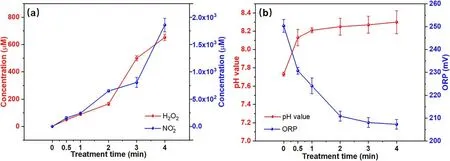
Figure 14.The concentration of RONS and physicochemical properties of PAM induced by air plasma jet (D=4 mm, V=18 kV, and F=0.5 SLM).

Figure 15.The air plasma jet induced cytotoxicity in A549 cells(V=18 kV,F=0.5 SLM,and D=4 mm).(a)Coloured images of plasma jet treated for different time obtained using an inverted microscope(the deactivated cells are stained blue)and(b)the percentage of apoptotic cells treated with PAM for 24 h.
4.Conclusion
In this study, we quantitatively studied the discharge characteristics of an air plasma jet under three types of parameters:gas flow rate, quartz tube diameter, and applied voltage with an air plasma jet driven by an AC power supply.The physicochemical properties and concentration of the reactive species in PAM were utilized to analyze the chemical activity.The results show that the tube diameter plays an important role in sustaining the voltage of the air plasma jet,and the gas flow affects the discharge mode: ozone and nitrogen oxide modes at high and low gas flow rates, respectively.The discharge voltage increases the concentration of reactive species and the length of discharge with increasing voltage.Based on the viability of A549 cells under different parameters, the optimal discharge conditions were selected as follows:V=18 kV,D=4 mm, andF=0.5 SLM.Under the optimized conditions, the air plasma jet effectively enhanced the chemical activity of PAM and produced more aqueous RONS.In addition,the optimal experimental conditions were selected to investigate cell apoptosis with an increase in treatment time.The activity of the cancer cells decreased to 13% after 4 min of plasma treatment.This may be related to H2O2and−NO2as well as their synergistic effects in acidic environments, which are regarded as the mechanism of tumour cell apoptosis induced by PAM.
Acknowledgments
This work is supported by National Natural Science Foundation of China (Nos.12075188, 52077166 and 51837008),and State Key Laboratory of Electrical Insulation and Power Equipment (No.EIPE20302).
Conflict of interest
The authors declare no conflict of interest.
猜你喜欢
杂志排行
Plasma Science and Technology的其它文章
- A study on nuclear analysis of the divertor region of the CFETR
- Evaluation of gases’ molecular abundance ratio by fiber-optic laser-induced breakdown spectroscopy with a metal-assisted method
- Thermophysical properties of pure gases and mixtures at temperatures of 300–30 000K and atmospheric pressure:thermodynamic properties and solution of equilibrium compositions
- Plasma treatment for enhancement of the sorption capacity of carbon fabric
- Parametric study of high-frequency characteristics of plasma synthetic jet actuator
- Energy properties and spatial plume profile of ionic liquid ion sources based on an array of porous metal strips
